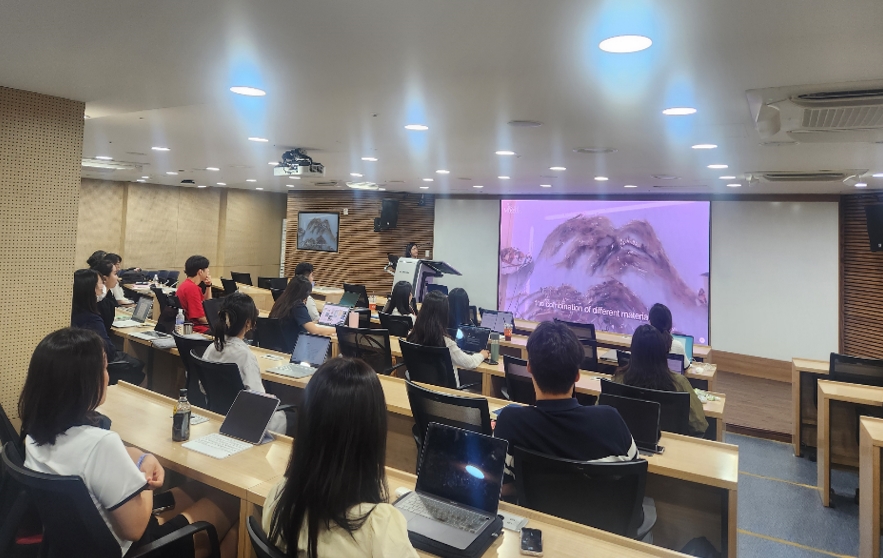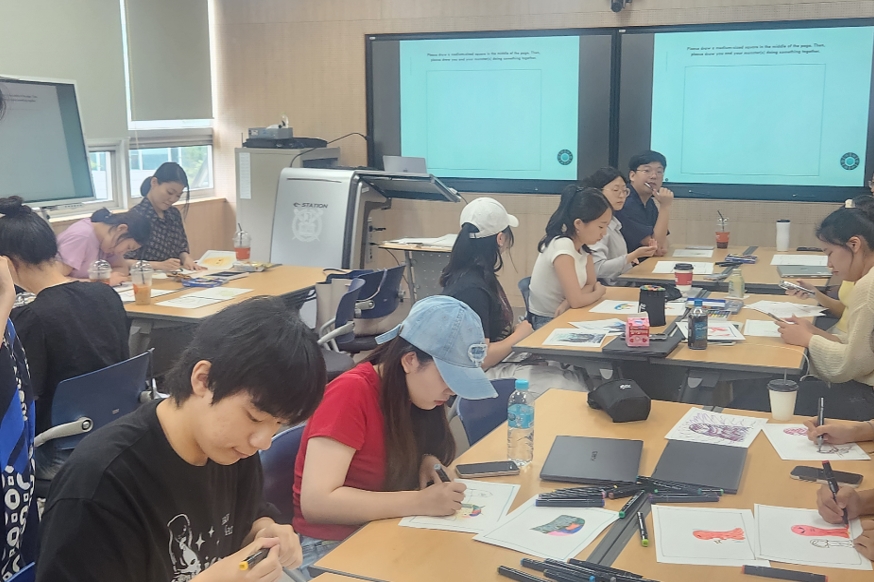On July 16, the Department of Child Development and Family Studies invited Professor Lee Seung Yeon from New York University to introduce the application of art in therapy and research for the department’s research methodology workshop held every semester. The department has been conducting these workshop every summer and winter to enhance understanding and interest in the field of Child and Family Studies by inviting various scholars and professors actively engaged in the field. Under the title “Art-Based Research in Art Therapy and Child Studies: Focus on Cultural Humility,” the workshop delved into what Art-Based Research (ABR) is, the role of art therapy in child studies, and studies on art therapy with migrants. The event was comprised of morning and afternoon sessions.
In the morning session, the emphasis was on the roles of art therapy in understanding children and their families, particularly displaced children, and in highlighting the importance of cultural humility. Professor Lee introduced clinical art therapy interventions and demonstrated how art-making and visual information can be used to gather qualitative data for related art-based research. In the afternoon, students participated in experiential activities and small group discussions, exploring the significance of art-making as a meaningful and vital component of art-based research.
Understanding Art-Based Research
Professor Lee defines ABR as the adaptation of creative arts principles to social research projects. She explained that during the art-making process, participants often generate new questions or thoughts, making artistic inquiry an integral part of ABR. Professor Lee builds on Shaun McNiff’s original conception of ABR. As a leading figure in the field, McNiff writes that artistic expressions can convey concepts beyond narrative and verbal ideas, offering a holistic and complete approach to one’s expressive energy. This allows for a deeper understanding and connection to personal and universal truths.
A painting by Henri Matisse titled Dance was introduced as an example. When asked how they would start research on this piece, most participants suggested using traditional tools like books. Professor Lee illustrated how ABR could offer a different approach, emphasizing the expressive and interpretative aspects of art. To showcase the diverse methods within ABR, another artist discussed was Xu Bing, who recreated Wang Ximin’s ink artwork using shadows of natural elements.

Professor Lee introducing artwork by Xu Bing
Professor Lee highlighted that ABR is not confined to art but extends to various fields, including social studies. For instance, ABR can be used to analyze the experiences of racial discrimination of Asian American employees in the workplace. Researchers can use photographs taken by the victims or performances reenacting these experiences to further understand the dynamics of discrimination. These methods demonstrate ABR’s versatility and its capacity to address complex social issues.
Art Therapy Case Studies
Since most recipients of art therapy engage in ABR, Professor Lee introduced various intervention cases. She discussed the significance of color and shapes in art and how creating art can transform the clients’ weaknesses into strengths. One example involved a person with hand tremor symptoms who, through the art-making process, created a piece reminiscent of Jackson Pollock’s paintings.
Professor Lee further introduced the concept of “flow”, an intense, focused concentration on the present moment through which individuals are empowered to gain control over their situation, in art therapy. A key characteristic of flow is the sense of time passing quickly, indicating readiness to pursue one’s goals. An illustrative case involved a child with ADHD who was able to maintain deep concentration for an hour to complete an art project.
Experiential Activities and Cultural Humility
In the afternoon session, participants engaged in ABR activities. They were asked to imagine and draw their own “monster,” then depict themselves doing something peaceful and happy with it on another sheet of paper. This exercise helped participants gain control over their fears by visualizing and coexisting with their “monster,” which can prevent a fight or flight response.

Participants drawing their “monster”
The final part of the session addressed interventions related to children of migrant families. Language barriers can lead to stress from language brokering, where children assist their less fluent parents with documents and assignments. This stress was depicted in a child’s clay artwork as a turtle being used for transportation.
Sharing her experiences with migrant families, Professor Lee emphasized the importance of cultural humility. She explained that cultural humility involves more than just knowledge of another culture; it requires self-reflection and gaining insight throughout the process to understand the culture holistically. This approach fosters a deeper, more empathetic understanding and bridges the gap between different cultural experiences.
The event underscored that ABR is a powerful tool not only in art education but also in broader social and therapeutic contexts. Through creative processes, ABR provides unique insights, ultimately contributing to a more comprehensive understanding of human behavior and social dynamics.
Written by Jeemin Suh, SNU English Editor, jiminasuh@snu.ac.kr

